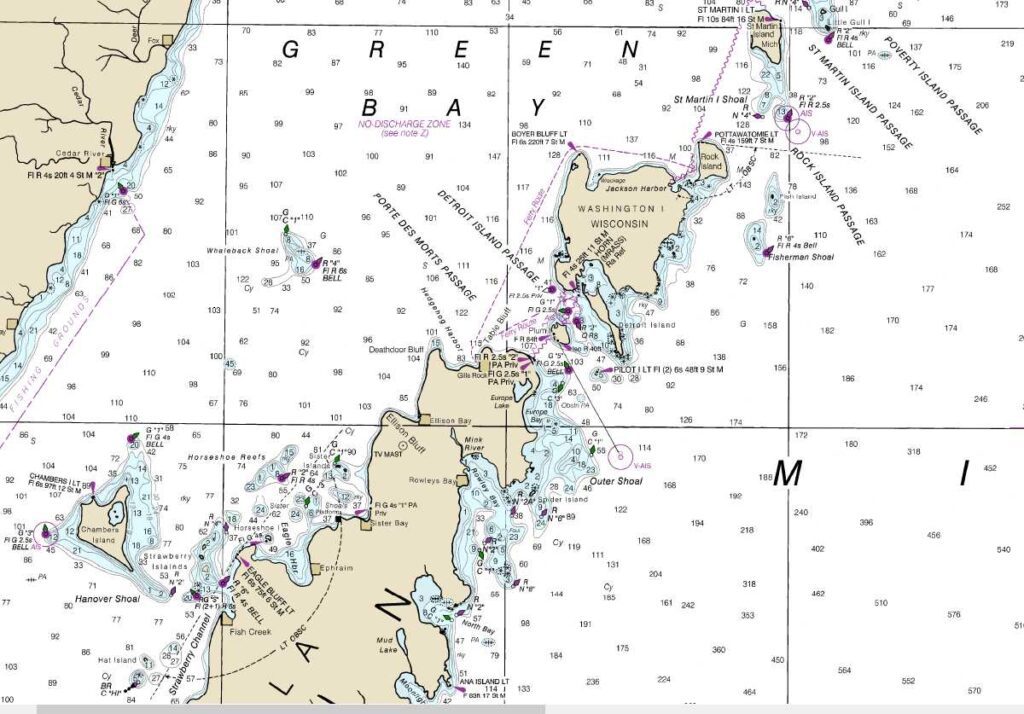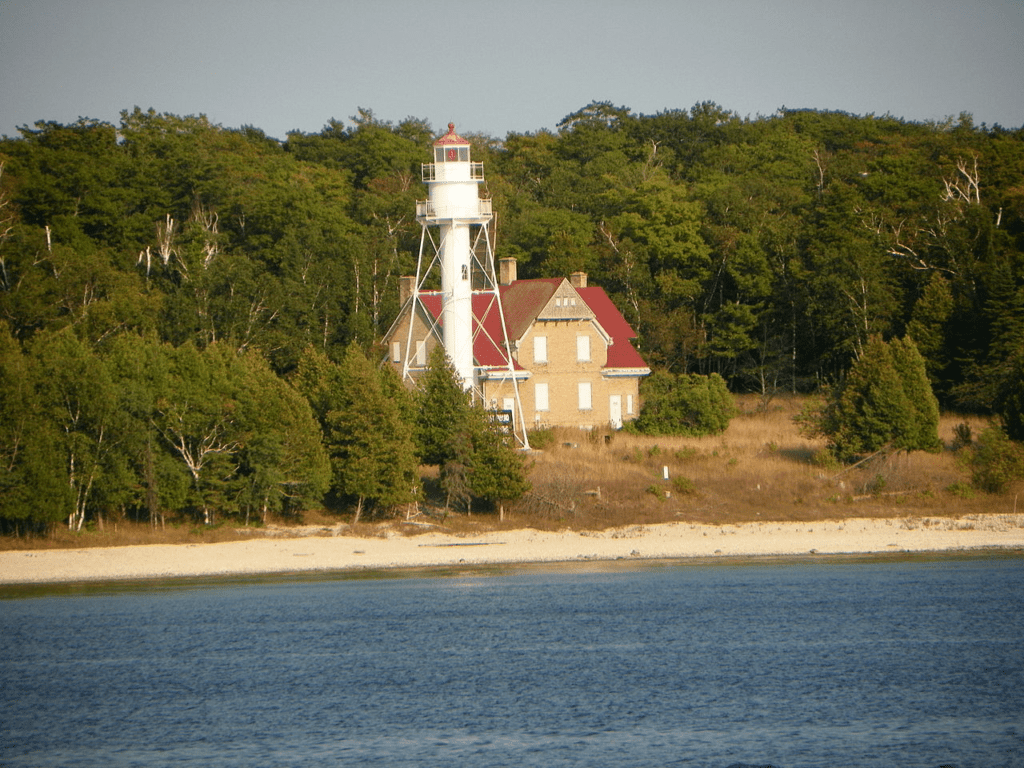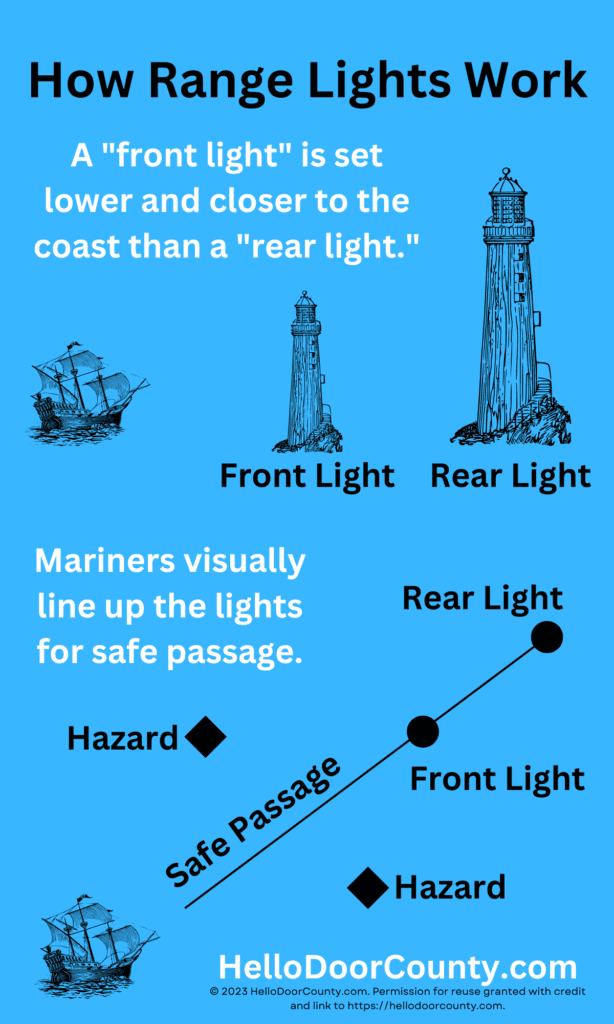Located in the treacherous waters of the Porte des Morts passage in Wisconsin, the Plum Island Lighthouse has been guiding mariners to safety for over a century. Originally built in response to the increasing shipping traffic in the mid-1800s, the lighthouse complex has undergone several changes and upgrades over the years, including automation in 1939 and the replacement of the front light with a steel tower in 1964. Today, the Plum Island Lighthouse is administered by the U.S. Fish and Wildlife Service and is part of the Green Bay National Wildlife Refuge. While access to the island is limited, visitors can still experience the history and significance of this landmark by taking an organized tour or visiting during permitted times.
Here is what we are going to cover in this post:
- How to see the Plum Island Lighthouse
- How to visit the Plum Island Lighthouse
- The History of the Plum Island Lighthouse
- What is a range light?
- Frequently Asked Questions
- Summary
In addition, make sure to check out our hub post on all of Door County’s 11 lighthouses.

Seeing the Plum Island Lighthouse
The easiest way to see the Plum Island Lighthouse is by taking the Washington Island Ferry. While the ferry does not pass closely to the lighthouse, they are still visible. Bring along a pair of binoculars to get a good look.
However, it is possible to not only see the Plum Island Lighthouse from a distance but also to get up close by visiting Plum Island itself.
Visiting the Plum Island Lighthouse
Visiting the Plum Island Lighthouse can be a unique and rewarding experience, but it is important to note that access is limited. The U.S. Fish and Wildlife Service, which administers Plum Island, permits visits to the lighthouse at certain times. It’s best to check their website for the most up-to-date information on when visits are allowed.
To get to the Plum Island Lighthouse, visitors must travel by private or charter boat. It is important to plan ahead and make arrangements for transportation in advance.
One of the easiest ways to visit the lighthouse is on an organized tour. These tours are often organized in conjunction with the Door County Lighthouse Festival, which takes place annually in Door County, Wisconsin. The festival typically includes tours of several area lighthouses, including the Plum Island Lighthouse, and provides a unique opportunity to learn about the history and significance of these landmarks.
It is important to note that while visiting the Plum Island Lighthouse by private boat is possible, it should only be attempted by well-outfitted and experienced mariners. This is because the waters of the Porte des Morts passage are extremely treacherous, and can be deadly without proper experience and equipment. If you are not an experienced mariner, it is highly recommended to go on an organized tour with a knowledgeable guide who can ensure a safe and informative visit to the Plum Island Lighthouse.
History of the Plum Island Lighthouse
The Need for a Range Light Identified
The need for a lighthouse on Plum Island was identified in the mid-1800s when shipping traffic increased significantly, particularly ships traveling from Detroit or Chicago that favored the Porte des Morts passage over the northerly Rock Island passage. However, this passage was extremely treacherous, and mariners needed a reliable guide to navigate it safely. In response to this need, Congress designated $3,500 in 1848 for the construction of a lighthouse to aid ships navigating the Porte des Morts passage.

The original lighthouse was constructed on Plum Island, but it was soon discovered that it was too far west to provide adequate guidance to mariners. Therefore, it was decided to move the lighthouse to Pilot Island in 1858, where it could provide better visibility to ships approaching the Porte des Morts passage.
However, it was determined that the placement of a single lighthouse was not sufficient to aid mariners in safely navigating the treacherous passage. To further aid mariners, it was decided that a range light was needed. Funding for the project was acquired in 1895, and construction of the range light began in 1896. The range light was strategically placed to work in tandem with the Plum Island Lighthouse, which was still in operation at the time. Together, the two lighthouses provided valuable assistance to mariners navigating the Porte des Morts passage, helping to prevent shipwrecks and other maritime disasters.
Construction of the Range Light

Construction of the Plum Island Lighthouse complex began in 1896, and it was designed to be a large and comprehensive system to aid in the navigation of the Porte des Morts passage. The complex consisted of several buildings, including a landing dock, a front light housed in a small wooden building, a rear light mounted on a 65-foot-tall steel tower, a two-story brick keepers’ dwelling that had three units for three keepers, a brick fog signal building, and wooden walkways to connect the buildings.
The size of the keepers’ dwelling was unusual, with three separate units, as so many keepers were necessary to maintain the lights and ensure safe passage in a busy waterway. In fact, the Plum Island Lighthouse complex was so important to navigation that it required a team of keepers to maintain it around the clock. The lighthouse was also equipped with state-of-the-art technology, including a Fresnel lens that was capable of producing a bright, focused beam of light that could be seen from many miles away.
Despite the complexity of the project, construction was completed in December 1896, and the Plum Island Lighthouse complex began operating soon after.
Automation to Today
In 1939, the Plum Island Lighthouse complex underwent a significant change when its lights were automated. This development eliminated the need for keepers, and the keepers’ dwelling was subsequently abandoned. With the automated lights in place, the complex continued to serve its purpose in guiding ships through the treacherous Porte des Morts passage, but with a reduced need for personnel.
In 1964, another change was made to the Plum Island Lighthouse complex when the front light was replaced by a steel tower. This upgrade further improved the effectiveness of the lighthouse in guiding ships safely through the waterway.
In 2007, Plum Island was absorbed by the Green Bay National Wildlife Refuge, which is administered by the U.S. Fish and Wildlife Service. Today, the U.S. Fish and Wildlife Service permits visits to Plum Island under certain conditions, which can be found on their website.
The Friends of Plum and Pilot Island have been instrumental in preserving and restoring the structures on Plum Island. They have worked tirelessly to maintain the lighthouse complex, ensuring that its historical significance and architectural beauty are preserved for future generations.
What Are Range Lights?
Range lights are a type of navigational aid that are commonly used to help mariners make safe passage past nautical hazards. They consist of two lights, a higher rear light and a lower front light, that are separated from each other by a distance. When these two lights are lined up, the mariner knows that they are traveling in a safe passage.
The Plum Island Lights are a perfect example of this type of navigational aid. The upper and lower lights are located on separate structures, which are positioned in such a way that they form a line of sight that can be used to guide ships safely into the harbor. The upper light is located on a higher tower, while the lower light is situated on a shorter tower.
One of the key benefits of range lights is that they are relatively easy to maintain and operate. Unlike other types of navigational aids, such as buoys or beacons, range lights require very little maintenance once they are installed. Additionally, they are relatively inexpensive to operate, making them a popular choice for many mariners.
Overall, range lights are an essential component of many navigational systems, and they have helped countless mariners safely navigate through hazardous waters. The Plum Island Range Lights are a prime example of the important role that range lights have played in the development of the Great Lakes region, and they serve as a reminder of the rich maritime history of the area.

Frequently Asked Questions
Yes, it is possible to visit the lighthouse, but it can be difficult as it requires a private or charter boat. The U.S. Fish and Wildlife Service permits visits at certain times, and organized tours are available during the Door County Lighthouse Festival.
The keepers’ dwelling was a two-story brick building with three units for three keepers. It was abandoned after the lights were automated in 1939. Today, the Friends of Plum and Pilot Island work to preserve and restore the building.
The Porte des Morts passage is known for its treacherous waters, and the Plum Island Lighthouse played a vital role in guiding ships through the passage. The lights were automated in 1939, but the steel tower and the light on Pilot Island continue to help mariners navigate this dangerous waterway.
Summary
- Plum Island Lighthouse was built in response to increasing shipping traffic in the mid-1800s.
- The lighthouse complex includes a front and rear light, brick keepers’ dwelling, fog signal building, and wooden walkways.
- The lights were automated in 1939, and the keepers’ dwelling was abandoned.
- The front light was replaced by a steel tower in 1964.
- Plum Island was absorbed by the Green Bay National Wildlife Refuge in 2007, and is administered by the U.S. Fish and Wildlife Service.
- Visiting the lighthouse is difficult but possible through organized tours or private boats, but requires proper experience and equipment due to the treacherous waters of the Porte des Morts passage.
- The Friends of Plum and Pilot Island work to preserve and restore the structures on Plum Island.
